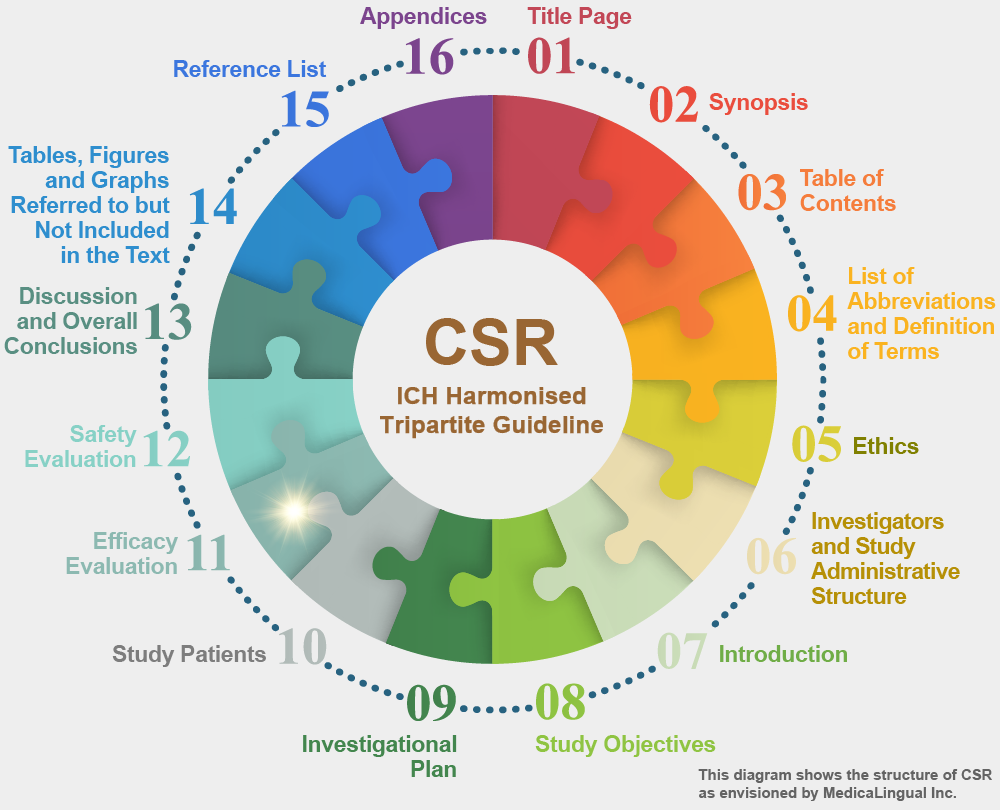
治験の統括報告書の構成と内容に関するガイドライン
平成8年5月1日 薬審第335号
各都道府県衛生主管部(局)長あて 厚生省薬務局審査課長通知
STRUCTURE AND CONTENT OF CLINICAL STUDY REPORTS
Recommended for Adoption at Step 4 of the ICH Process on 30 November 1995 by the ICH Steering Committee
11. 有効性の評価
11.2 人口統計学的及び他の基準値の特性
患者の特に重要な人口統計学的及び基準値の特性について,群別のデータを提示すること。同様に,治験期間中に発生した反応に影響を与えた可能性のある他の因子についてもこの節で提示すること。さらに,全ての関連する特性についての治療群間の比較可能性を表又は図を用いて14.1節に記述すること。「データのある全ての患者」の解析に用いた患者標本についてのデータを最初に示すこと。次に,例えば治験実施計画書に基づいた解析,その他の主たる解析に用いられた,例えば遵守状況,合併症・併用療法又は人口統計学的・基準値の特性により限定される他の患者群についてのデータを示すこと。このような患者群を用いるときは,補足的に除外された患者群のデータも示すこと。多施設共同治験においては,適切であれば,比較可能性を施設ごとに検討し,施設間で比較すること。
11. EFFICACY EVALUATION
11.2 DEMOGRAPHIC AND OTHER BASELINE CHARACTERISTICS
Group data for the critical demographic and baseline characteristics of the patients, as well as other factors arising during the study that could affect response, should be presented in this section and comparability of the treatment groups for all relevant characteristics should be displayed by use of tables or graphs in section 14.1. The data for the patient sample included in the “all patients with data” analysis should be given first. This can then be followed by data on other groups used in principal analyses, such as the “per-protocol” analysis or other analyses, e.g., groups defined by compliance, concomitant disease/therapy, or demographic/baseline characteristics. When such groups are used, data for the complementary excluded group should also be shown. In a multicentre study where appropriate, comparability should be assessed by centre, and centres should be compared.
患者標本全体と他の全ての解析対象群との関係を表すダイアグラムを示すこと。
疾患の特性及び治験実施計画書にもよるが,特に重要な変数には,通常,下記疾患の項目が含まれる。
♦ 人口統計学的変数
-年齢
-性
-人種
♦ 疾患因子
-疾患ごとの組み入れ基準(一定でない場合),罹病期間,疾患の病期と重症度,並びに通常用いられるか又は予後因子として知られている他の臨床上の分類及び部分集団
-治験中に測定されるか又は予後や治療に対する反応の重要な指標とされている,特に重要な測定項目の基準値
-治験開始時の腎疾患,糖尿病,心不全などの合併症
-関連する過去の疾患
-当該治験で治療する疾患に関連する前治療
-経口避妊薬,ホルモン補充療法を含む治験期間中に継続された併用療法(用量が変更されたものも含む);治験期間へ入る際に中断された(又は治験開始時に変更された)治療
♦ 治療に対する反応に影響する可能性のある他の因子(例えば,体重,レニン系の状態,抗体水準,代謝系の状態)
♦ 他の関連すると考えられる因子(例えば,喫煙,アルコール摂取,特殊な食事)並びに女性に対しては,治験に関係する場合には月経状態及び閉経時期
A diagram showing the relationship between the entire sample and any other analysis groups should be provided.
The critical variables will depend on the specific nature of the disease and on the protocol but will usually include:
♦ demographic variables
– age
– sex
– race
♦ disease factors
– specific entry criteria (if not uniform), duration, stage and severity of disease and other clinical classifications and sub-groupings in common usage or of known prognostic significance
– baseline values for critical clinical measurements carried out during the study or identified as important indicators of prognosis or response to therapy
– concomitant illness at trial initiation, such as renal disease, diabetes, heart failure
– relevant previous illness
– relevant previous treatment for illness treated in the study
– concomitant treatment maintained, even if the dose was changed during the study, including oral contraceptive and hormone replacement therapy; treatments stopped at entry into the study period (or changed at study initiation)
♦ other factors that might affect response to therapy (e.g., weight, renin status, antibody levels, metabolic status)
♦ other possibly relevant variables (e.g., smoking, alcohol intake, special diets) and, for women, menstrual status and date of last menstrual period, if pertinent for the study.
これらの基準変数に関する各群のデータを表及び図を用いて提示すること。さらに,臨床検査値を含む個別の患者の人口統計学的データ及び基準値,並びに無作為化された全ての患者に対する全ての併用療法(多施設共同治験では治療ごと及び施設ごとの内訳)を患者ごとの一覧表にして付録16.2.4に添付すること。
In addition to tables and graphs giving group data for these baseline variables, relevant individual patient demographic and baseline data, including laboratory values, and all concomitant medication for all individual patients randomised (broken down by treatment and by centre for multicentre studies) should be presented in by-patient tabular listings in appendix 16.2.4. Although some regulatory authorities will require all baseline data to be presented elsewhere in tabular listings, the appendix to the study report should be limited to only the most relevant data, generally the variables listed above.
ガイドライン ― Q&A
人口統計学的特性
Q10:治験対象集団の人口統計学的特性とは,具体的に何を指すのか。
A10:人口統計学的特性とは,疾患の状態を直接には特定しないような治験対象集団の一般的な特性であって,人口統計の基礎的情報となるような因子を指す。本ガイドラインの序文には具体的に,「人口統計学的な(例えば,年齢,性,人種,体重の)部分集団や,その他(例えば,腎機能や肝機能)の部分集団に関するデータ」との表現がある。
***










